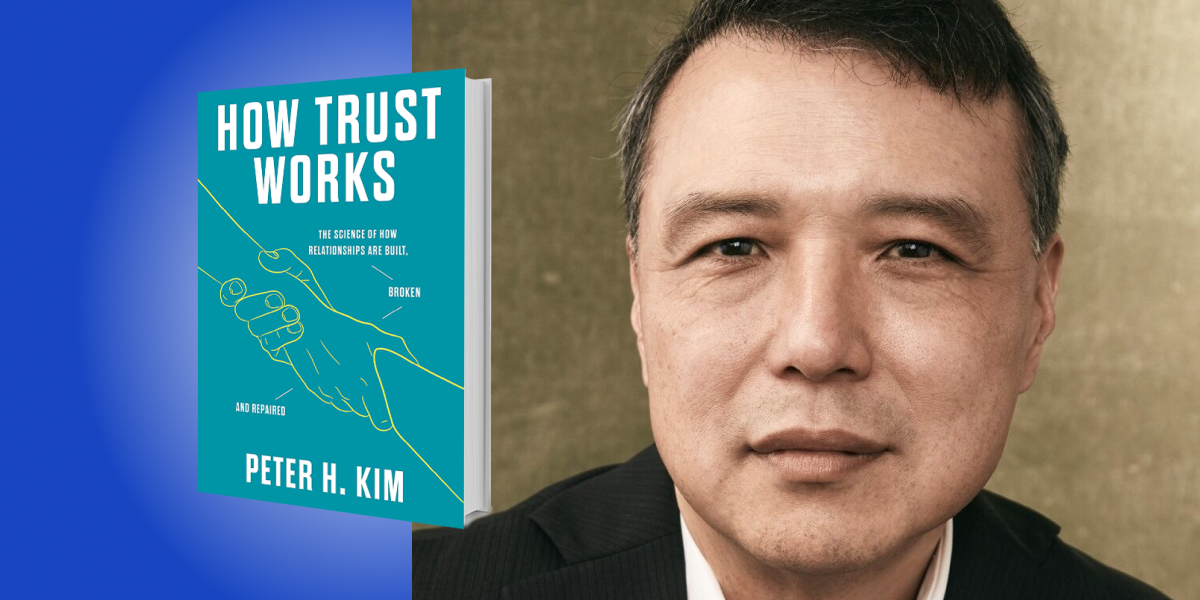Peter H. Kim a professor of management and organization at the University of Southern California’s Marshall School of Business. His research on trust has been published in numerous scholarly journals, received national and international awards, and has been featured by the New York Times, Washington Post, and National Public Radio.
Below, Peter shares five key insights from his new book, How Trust Works: The Science of How Relationships are Built, Broken and Repaired. Listen to the audio version—read by Peter himself—in the Next Big Idea App.

1. You are not as cynical as you think.
One of our most common assumptions is that trust starts at zero and only builds gradually over time as we learn more about one another. It turns out that this is far from true. Evidence suggests that we exhibit surprisingly high levels of trust in those we don’t know and that we do so for a host of reasons.
This discrepancy between how we think trust works and how we trust in real life is underscored whenever we dine at a new restaurant. Every time we do, we are trusting countless strangers who were involved in that meal. This includes farmers, wholesalers, distributors, cooks, and other restaurant staff we have never met. That decision is also not without real danger. There are over 73,000 cases of potentially deadly e-coli infections each year that are transmitted through food. That’s a big deal. But we make these kinds of trusting decisions all the time
The evidence makes clear that this willingness to trust those we don’t know is actually a good thing. Rather than simply making us naïve or gullible, this willingness to trust generally makes us better off by making us happier, expanding our opportunities, and ultimately making us more successful.
2. Consider the “why.”
When trust is violated, we typically focus on whether the offender has apologized. That kind of response can certainly matter. But it turns out that the effectiveness of apologies, and other trust repair efforts, often depends as much on how the offense is viewed. Apologies, for example, can often elicit dramatically different reactions to an offender, as we can see with many public figures who have apologized for their sexual transgressions.
“It’s the story that determines how that apology is ultimately received or rejected.”
This is because, just as important as whether someone apologizes or not, are people’s beliefs about why the violation occurred. It’s the story that determines how that apology is ultimately received or rejected. The problem, though, is that we tend to overlook this essential part of the equation by simply assuming what those beliefs might be. This is much like trying to avoid traffic accidents by only looking straight ahead and ignoring the cross-traffic.
3. It’s probably not that simple.
One of the most important ways we make sense of trust violations is by deciding whether they stem from a lack of competence or integrity. Competence and integrity are the two most important bases of trust. Whether we view trust violations as a matter of competence or integrity can make an enormous difference in how the exact same attempt to repair trust is viewed.
It’s a big reason we need to consider the “why,” in addition to the response. But even when we do consider the why, we tend to do it far too simplistically, despite the fact that this choice can make an enormous difference in the trust we exhibit. We tend to make these decisions in a reflexive manner. We often fail to explore competing explanations for these incidents or the possibility that there was more than one cause. The decision is often based on what we are motivated to think, rather than what really happened.
These issues underscore how violators are not the only ones responsible for the repair of trust. Their perceivers have a responsibility as well. The perceivers are responsible for investigating what happened and why, to the very best of their ability. That way, they can calibrate their trust more effectively.
4. Your balance sheet is broken.
The repair of trust is ultimately about guilt and redemption. These considerations are also at the core of some of our most timeless fictional and real-life stories. But despite the central role these judgments so often play, our assumptions about how that’s done are often wrong.
We tend to think this involves an approach not too different from how we manage a checking account. Our good deeds add to the account as credit and our bad deeds subtract from the account as debits. We can then tally up each side of the ledger to gauge whether someone is good enough to be trusted again. However, the evidence suggests that this process is easily distorted in ways that we fail to anticipate.
“Our good deeds add to the account as credit and our bad deeds subtract from the account as debits.”
There are times when even a single bad act can overwhelm a lifetime of good. This can also lead those who perceive these actions to reach very different conclusions than the actors themselves. This means that even when people try to maintain their moral standing by making sure their bad deeds are outweighed by the good, they may ultimately be surprised to discover they are being considered unethical and untrustworthy after all.
5. Good people can disagree about what integrity means.
When others do things that run counter to our values, it’s natural to infer that their integrity is low. That kind of perception is particularly difficult to correct. We should note, however, that even though most of us tend to share the same moral principles, different people, groups, and cultures prioritize those principles differently.
This can cause us to reach different conclusions about what’s appropriate and those differences can then lead us to quickly condemn others’ actions as irredeemably immoral. They, in turn, believe they are being unfairly maligned for acts they consider entirely justified. The result is then that trust becomes virtually impossible to repair.
We see this again and again in our increasingly polarized political discourse, where each side is focused on vilifying the other. But if these problems do stem from differences in how we prioritize the same moral principles, there’s an opportunity to treat these different views as matters, not of right vs. wrong, but rather of right vs. right.
We can then turn what might have otherwise been an intractable conflict, in which each side condemns the integrity of the other, into the more tractable problem of how best to negotiate the different ethical priorities of well-meaning people.
To listen to the audio version read by author Peter Kim, download the Next Big Idea App today:































